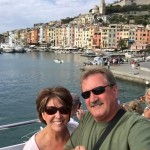 One of the most wonderfully preserved medieval towns in Italy, Siena is more than just a charming place to experience the Tuscan heartland. Siena is the city where you don’t have to go inside a museum to see its most famous works of art. The town itself, its twisting medieval alleys and bright open piazze, is really what you’ve come to see. But don’t worry, if it’s museums you’re after then you’ve still come to the right place.
One of the most wonderfully preserved medieval towns in Italy, Siena is more than just a charming place to experience the Tuscan heartland. Siena is the city where you don’t have to go inside a museum to see its most famous works of art. The town itself, its twisting medieval alleys and bright open piazze, is really what you’ve come to see. But don’t worry, if it’s museums you’re after then you’ve still come to the right place.
Siena is located south of Florence, only about an hour’s train ride from Tuscany’s capital city. Though most visitors speed through on a day trip, Siena is well worth an overnight stay, if only to view the Campo piazza dressed in its nightly lights and splendor. You’ll find plenty of home-style restaurants and opportunities to try Tuscany’s regional cooking, and of course, there are plenty of wines to be savored. In short, Siena should be included in the itinerary for your next trip to Italy.
What to See in Siena
Aside from getting lost in Siena’s labyrinthine cobbled streets and exploring its picturesque alleys, there are definitely some beautiful places not to be missed. The reason for Siena’s excellent state of preservation is because its urban development, which took place between 1287 and 1355, remained untouched in subsequent years. During its height, Siena was considered one of Europe’s major cities, but this status didn’t last past the late Middle Ages.
Il Campo and the Palazzo Pubblico are two fine examples of the building achievements during those booming Sienese years. Il Campo is the undisputed center of the city, and it’s not hard to see why. Walking through the town you’ll find that you’re drawn almost helplessly to the scallop shaped square. Join others basking in the sun in the center or grab a coffee along the periphery where the Palio horserace takes place in July and August. It’s difficult to imagine horses and their bareback riders tearing around the square on a normal day, but it does happen twice a year!
Look closely and you’ll see that the Campo was constructed on the convergence of three hills that divide the town into thirds or terzi. The main streets lead out from the Campo on their own elevated ridge. The Fonte Gaia by Jacopo della Quercia is the only Renaissance addition to the piazza, though the present one is a poor nineteenth century reproduction.
The Palazzo Publico and its Torre del Mangia dominate the south side of the piazza. The palazzo is still used as Siena’s town hall, but the best rooms can be visited under the guise of the Museo Civico. Check out the Sala del Mappamondo for Simone Martini’s Maestà and the Sala della Pace for Ambrogio Lorenzetti’s famous Allegories of Good and Bad Government, a good fresco for any official to ponder.
If you’re looking for some exercise, climb the Torre del Mangia bell tower and take in the sweeping views of Siena and the surrounding Tuscan countryside.
 The next major stop is the Duomo. A breathtaking church with a Romanesque and Gothic facade. You may be shocked though, by first your first sight of the alternating bands of black and white marble that cover the church both inside and out. Completed in 1215, the Duomo has a strikingly modern look. The zebra stripes continue inside and can feel a little overwhelming when paired with the colorful mosaic panels of the floor and the dizzying array of popes’ heads above the pillars! Also worth a peek is the Libreria Piccolomini where you’ll see bright frescoes depicting the life of Aeneas—Pope Pius II—by Pinturicchio.
The next major stop is the Duomo. A breathtaking church with a Romanesque and Gothic facade. You may be shocked though, by first your first sight of the alternating bands of black and white marble that cover the church both inside and out. Completed in 1215, the Duomo has a strikingly modern look. The zebra stripes continue inside and can feel a little overwhelming when paired with the colorful mosaic panels of the floor and the dizzying array of popes’ heads above the pillars! Also worth a peek is the Libreria Piccolomini where you’ll see bright frescoes depicting the life of Aeneas—Pope Pius II—by Pinturicchio.
If you’re wondering where all the good stuff from the Duomo’s history is stored, head over to the Museo dell’Opera. There are also great views of the city here. Of artistic importance are statues by Donatello and the Maestà by Duccio, which was the Duomo’s altarpiece for two hundred years.
Eating and Drinking
Siena has lots of tasty and authentic Italian restaurants to tempt the palate. In many local osterie you can try picci, the local handmade thick pasta that’s topped with a variety of sauces; finocchiona, minced pork with fennel; or fagioli all’uccelletto, white beans with sausages. The Tuscans like to dig into some hearty fare, good for the cooler months.
It’s the sweet treats in Siena though, that are the stars. There’s the panforte, a dense nut, fruit, and honey wedge eaten by soldiers for sustenance as they marched out to battle. You’ll find it sold in many shops throughout the city. Then there are any of the city’s biscuits, like cavallucci, a delicious combination of aniseed, nut and spice. Make sure you satisfy your sweet tooth at a pasticcerie where you can buy by the etto, or 100 grams.
Nestled in the heart of Tuscany, Siena is a great place to try the wines from neighboring cities. Most notable of course, are those from the vineyards of Chianti, Montepulciano, and Montalcino. You can really get to know Siena and the Tuscan heartland with our 5 Day Taste of Tuscany Tour.






